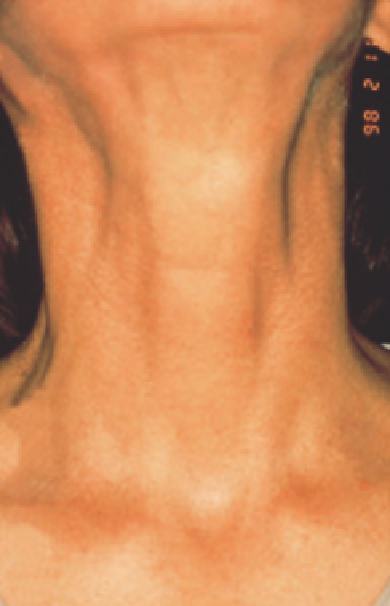Biomedical Engineering Reference
In-Depth Information
resurfacing of the neck with the UltraPulse CO
2
laser (268).
Another study by Rosenberg also reported scarring of the
lower neck after resurfacing with the UltraPulse laser (269).
Given the high rate of complications found in previous studies,
resurfacing of the neck with the CO
2
laser is considered relatively
contraindicated by most experts today. In contrast, resurfacing of
the neck, arms, and hands has been safely and effectively accom-
plished with Er:YAG laser systems (Fig. 6.37). Goldberg et al.
resurfaced the neck skin of 10 patients with four passes of a
short-pulsed Er:YAG laser at a fl uence of 3-4.5 J/cm
2
. At the
6-month follow-up, they noted at least a 25% improvement in
wrinkling and 50% improvement in mottled dyspigmentation.
No scarring or pigmentary complications occurred (14). Gold-
man et al. evaluated the results of neck resurfacing with an
Er:YAG laser (Derma-20, ESC Medical Systems, Needham, Mas-
sachusetts, USA. This is now made by Lumenis) in 20 patients.
Fluences of 8.7-13.5 J/cm
2
and spot sizes of 4-5 mm were used
for the fi rst pass and 2-9 J/cm
2
and 5- to 10-mm spot diameters
for the second pass. In total, 51% of patients were satisfi ed with
their results, and 39% improvement in texture and 37% improve-
ment in skin color were noted. All patients healed within
7-10 days and no permanent adverse side effects occurred (15).
Jimenez and Spencer resurfaced the skin of the neck, hands, and
forearms of 12 patients with a 300-
Pigmentary disturbances in patients with Fitzpatrick skin pho-
totypes III and higher have been a frequent complication of CO
2
laser skin resurfacing (16-18,101). The reported incidence of pig-
mentary alterations after Er:YAG laser skin resurfacing of patients
with darker skin phototypes (Fitzpatrick skin phototype III or
higher) is signifi cantly lower than that reported after CO
2
laser
skin resurfacing. The Er:YAG laser has shown a clear advantage
over the CO
2
laser in the resurfacing of patients with darker (III-
VI) Fitzpatrick skin phototypes (2). Polnikorn et al. utilized the
Er:YAG laser to treat 50 Asian patients (Fitzpatrick skin photo-
types III and IV) with rhytides, photodamage, acne, and varicella
scars. Signifi cant improvement was noted in all patients. Although
30% of patients experienced transient hyperpigmentation, only
one patient developed transient hypopigmentation (271).
The Er:YAG laser has also proven useful for removal of part of
the zone of thermal damage left behind after CO
2
laser resurfac-
ing, a technique that has been shown to decrease the duration of
postoperative erythema and healing time. Several studies have
documented the positive impact of Er:YAG laser resurfacing on
postoperative recovery when performed immediately after
CO
2
laser resurfacing. Goldman and colleagues randomized
10 patients to receive three passes with the CO
2
laser alone
(300 mJ, CPG settings of 596, 595, and 584) to one side of the
face and two CO
2
laser passes (300 mJ, CPG settings of 596 and
595) followed immediately by two passes with the Er:YAG laser
(Derma-20 or Derma-K, ESC Medical systems; 4-mm spot,
14 J cm
2
now made by Lumenis). They noted faster reepithelial-
ization (1-2 days faster) and decreased duration of postopera-
tive erythema (2-3 weeks vs. more than 8 weeks) in those areas
treated with the CO
2
-Er:YAG laser combination (Fig. 6.38). This
benefi cial effect was accomplished without compromising clini-
cal outcome (31). McDaniel et al. randomized 40 treatment
s pulsed Er:YAG laser with a
5-mm spot size at a fl uence of 5 J/cm
2
. Two to three passes were
performed on the arm and forearms and one or two passes were
performed on the neck. Overall, they reported a mild improve-
ment in photodamage and the majority of patients were pleased
with their results. Healing took 2-3 weeks and two of seven
patients who underwent resurfacing of the hands and forearms
developed infections that were successfully treated. No scarring
or permanent pigmentary alterations were observed (270).
μ
(
A
)
(
B
)
Figure 6.37
Treatment of neck using erbium laser allows removal of photodamaged epidermis without dermal injury. Improvement of skin texture and blending
of color are reasonable goals. Improvement of 40-50% has been observed. (
A
) Before treatment; (
B
) 4 months postoperatively.

















